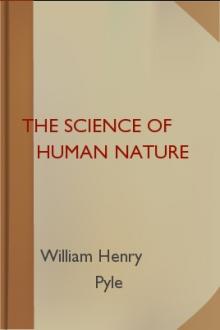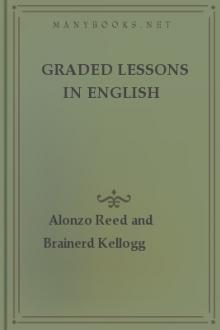The Science of Human Nature, William Henry Pyle [best pdf ebook reader .txt] 📗

- Author: William Henry Pyle
- Performer: -
Book online «The Science of Human Nature, William Henry Pyle [best pdf ebook reader .txt] 📗». Author William Henry Pyle
The selection and arrangement of the studies in the curriculum must be based on other grounds than the laws of memory. What children make most progress in and need most to know are the concrete things of their physical and social environment. Children must first learn the world—the woods and streams and birds and flowers and plants and animals, the earth, its rocks and soils and the wonderful forces at work in it. They must learn man,—what he is and what he does and how he does it; how he lives and does his work and how he governs himself. They should also learn to read and to write their mother tongue, and should learn something of that great store of literature written in the mother tongue.
The few that are to be scholars in language and literature must wait till beginning professional study before taking up their foreign language; just as a person who is to be a lawyer or physician must also wait till time to enter a university before beginning special professional preparation. The child’s memory for abstract conceptions is particularly weak in early years; hence studies should be so arranged as to acquaint the child with the concrete aspects of the world first, and later to acquaint him with the abstract relations of things. Mathematics should come late in the child’s life, for the same reason. Mathematics deals with quantitative relations which the child can neither learn nor remember profitably and economically till he is more mature. The child should first learn the world in its descriptive aspects.
Memory and Habit. The discussion up to this point should have made it clear to the reader that memory is much the same thing as habit. Memory considered as retention depends upon the permanence of the impression on the brain; but in its associative aspects depends on connections between brain centers, as is the case with habit. The association of ideas, which is the basis of their recall, is purely a matter of habit formation.
When I think of George Washington, I also think of the Revolution, of the government, of the presidency, of John Adams, Thomas Jefferson, etc., because of the connections which these ideas have had in my mind many times before. There is a basis in the brain structure for these connections. There is nothing in any idea that connects it with another idea. Ideas become connected because of the way in which we experience them, and the reason one idea calls up another idea is because the brain process that is the cause of one idea brings about another brain process that is the cause of a second idea. The whole thing is merely a matter of the way the brain activities become organized. Therefore the various laws of habit-formation have application to memory in so far as memory is a matter of the association of ideas, based on brain processes.
One often has the experience of trying to recall a name or a fact and finds that he cannot. Presently the name or fact may come, or it may not come till the next day or the next week. What is the cause of this peculiar phenomenon? The explanation is to be found in the nervous system. When one tries to recall the name and it will not come to mind, there is some temporary block or hindrance in the nerve-path that leads from one center to the other and one cannot think of the name till the obstruction is removed. We go on thinking about other things, and in the meantime the activities going on in the brain remove the obstruction; so when the matter comes up again, the nerve current shoots through, and behold, the name comes to mind.
Figure IV—Associative Connections
The diagram represents schematically the neural basis of the association of ideas.
Now the only preventive of such an occurrence is to be found in the law of habit, for the block ordinarily occurs in case of paths or bonds not well established. We must think together the things we wish to have associated. Repetition is the key to the situation, repetition which is the significant thing in habit-formation, repetition which is the only way of coupling two things which we wish to have associated together.
Of course, there is no absolute coupling of two ideas. One sometimes forgets his own name. When we are tired or ill, things which were the most closely associated may not hang together. But those ideas hold together in the firmest way that have been experienced together most often in a state of attention. The diagram on page 147 illustrates schematically the neural connections and cross-connections which are the bases of the association of ideas, the circles A, B, C, D, E, and F represent brain processes which give rise to ideas, and the lines represent connecting paths. Note that there are both direct and indirect connections.
Summary. Sensation and perception give us our first experience with things; memory is revived experience. It enables us to live our experience over again and is therefore one of the most important human traits. The physiological basis of memory is in the brain and nervous system. Memory improves with practice and up to a certain point with the age of the person. It is better in girls than in boys. Good memory depends on vivid experience in the first place and on organization and repetition afterward. The person who learns quickly usually retains well also. Memory training is specific. The extension of the learning process over a long time is favorable to memory. Memory ideas are the basis of thinking and reasoning.
CLASS EXERCISESThe teacher can test the auditory memory of the members of the class for rote material by using letters. It is better to omit the vowels, using only the consonants. Prepare five groups of letters with eight letters in a group. Read each group of letters to the class, slowly and distinctly. After reading a group, allow time for the students to write down what they recall, then read the next group and so proceed till the five groups have been read. Grade the work by finding the number of letters reproduced, taking no account of the position of the letters.
In a similar way, test visual memory, using different combinations of letters. Write the letters plainly on five large squares of cardboard. Hold each list before the class for as long a time as it took to read a group in experiment No. 1.
Test memory for words in a similar way. Use simple words of one syllable, making five lists with eight words in a list.
Test memory for objects by fastening common objects on a large cardboard and holding the card before the class. Put eight objects on each card and prepare five cards. Expose them for the same length of time as in experiment No. 2.
Test memory for names of objects by preparing five lists of names, eight names in a list, and reading the names as in experiment No. 1.
You now have data for the following study: Find the average grade of each student in the different experiments. Find the combined grade of each student in all the above experiments. Do the members of the class hold the same rank in all the tests? How do the boys compare with the girls? How does memory for objects compare with memory for names of objects? How does auditory memory compare with visual? What other points do you learn from the experiments?
The teacher can make a study of the logical memory of the members of the class by using material as described on page 184. Make five separate tests, using stories that are well within the comprehension of the class and that will arouse their interest. Sufficient material will be found in the author’s Examination of School Children and Whipple’s Manual. However, the teacher can prepare similar material.
Do the students maintain the same rank in the separate tests of experiment No. 7? Rank all the students for their combined standing in all the first five tests. Rank them for their combined standing in the logical memory tests. Compare the two rankings. What conclusions are warranted?
You have tested, in experiment No. 7, logical memory when the material was read to the students. It will now be interesting to compare the results of No. 7 with the results obtained by allowing the students to read the material of the test. For this purpose, select portions from the later chapters of this book. Allow just time enough for the selection to be read once slowly by the students, then have it reproduced as in the other logical memory experiment. Give several tests, if there is sufficient time. Find the average grade of each student, and compare the results with those obtained in No. 7. This will enable you to compare the relative standing of the members of the class, but will not enable you to compare the two ways of acquiring facts. For this purpose, the stories would have to be of equal difficulty. Let the members of the class plan an experiment that would be adequate for this purpose.
A brief study of the improvement of memory can be made by practicing a few minutes each day for a week or two, as time permits, using material that can be easily prepared, such as lists of common words. Let the members of the class plan the experiment. Use the best plan.
The class can make a study of the relation of memory to school standing in one of the grades below the high school. Give at least two tests for logical memory. Give also the rote memory tests described on page 189. Get the class standing of the pupils from the teacher. Make the comparison as suggested in Chapter I, page 15. Or, the correlation can be worked out accurately by following the directions given in the Examination of School Children, page 58, or in Whipple’s Manual, page 38.
Let the members of the class make a plan for the improvement of their memory for the material studied in school. Plan devices for learning the material better and for fixing it in memory. At the end of the course in psychology, have an experience meeting and study the results reported.
Prepare five lists of nonsense syllables, with eight in a list. Give them as in experiment No. 3, and compare the results with those of that experiment. What do the results indicate as to the value to memory of meaningful material? What educational inferences can you make? In preparing the syllables, put a vowel between two consonants, and use no syllable that is a real word.
A study of the effects of distractions on learning and memory can be made as follows: Let the teacher select two paragraphs in later chapters of this book, of equal length and difficulty. Let the students read one under quiet conditions and the other while





Comments (0)